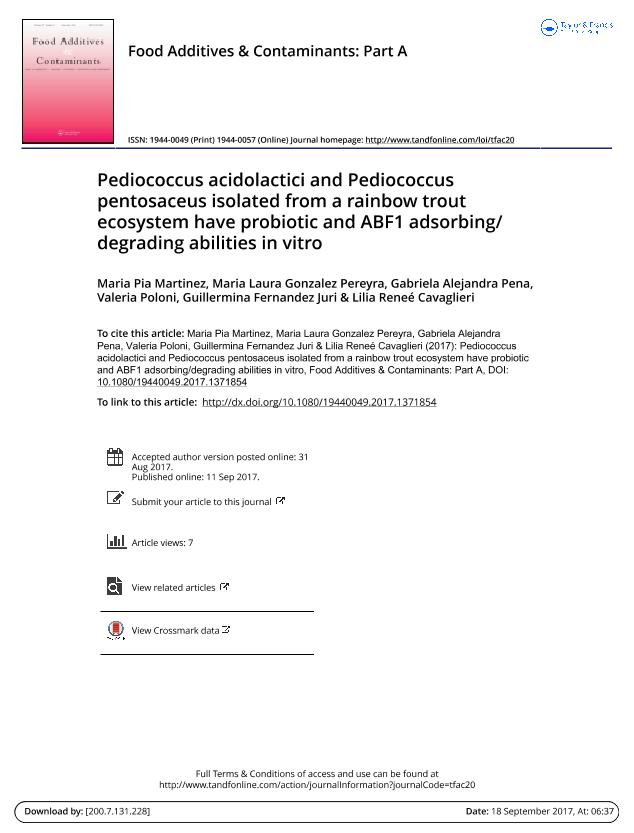Mostrar el registro sencillo del ítem
dc.contributor.author
Martinez, Maria Pia

dc.contributor.author
Gonzalez Pereyra, Maria Laura

dc.contributor.author
Pena, Gabriela Alejandra

dc.contributor.author
Poloni, Valeria Lorena

dc.contributor.author
Fernandez Juri, Maria Guillermina

dc.contributor.author
Cavaglieri, Lilia Reneé

dc.date.available
2022-11-24T14:26:07Z
dc.date.issued
2017-09
dc.identifier.citation
Martinez, Maria Pia; Gonzalez Pereyra, Maria Laura; Pena, Gabriela Alejandra; Poloni, Valeria Lorena; Fernandez Juri, Maria Guillermina; et al.; Pediococcus acidolactici and Pediococcus pentosaceus isolated from a rainbow trout ecosystem have probiotic and ABF1 adsorbing/degrading abilities in vitro; Taylor & Francis; Food Additives & Contaminants: Part A; 34; 12; 9-2017; 2118-2130
dc.identifier.issn
1944-0049
dc.identifier.uri
http://hdl.handle.net/11336/178833
dc.description.abstract
Probiotics are being used in biological control of bacterial pathogens, as an alternative to antibiotics, to improve health and production parameters in fish farming. Fish farming production is severely affected by aflatoxins (AFs), which are a significant problem in aquaculture systems. Aflatoxins exert substantial impact on production, causing disease with high mortality and a gradual decline of reared fish stock quality. Some aspects of aflatoxicosis in fish, particularly its effects on the gastrointestinal tract, have not been well documented. The aim of the present study was to evaluate probiotic properties of lactic acid bacterial (LAB) strains isolated from rainbow trout intestine and feed. Moreover, AFB1-binding and/or degrading abilities were also evaluated to assess their use in the formulation of feed additives. Growth at pH 2, the ability to co-aggregate with bacterial pathogens, inhibition of bacterial pathogens, and determination of the inhibitory mechanism were tested. Aflatoxin B1 (AFB1) adsorption and degradation ability were also tested. All strains were able to maintain viable (107 cells ml?1) at pH 2. Pediococcus acidilactici RC001 and RC008 showed the strongest antimicrobial activity, inhibiting all the pathogens tested. The strains produced antimicrobial compounds of different nature, being affected by different treatments (catalase, NaOH and heating), which indicated that they could be H2O2, organic acids or proteins. All LAB strains tested showed the ability to coaggregate pathogenic bacteria, showing inhibition percentages above 40%. Pediococcus acidilactici RC003 was the one with the highest adsorption capacity and all LAB strains were able to degrade AFB1 with percentages higher than 15%, showing significant differences with respect to the control. The ability of some of the LAB strains isolated in the present work to compete with pathogens, together with stability against bile and gastric pH, reduction of bioavailability and degradation of AFB1, may indicate the potential of LAB for use in rainbow trout culture.
dc.format
application/pdf
dc.language.iso
eng
dc.publisher
Taylor & Francis

dc.rights
info:eu-repo/semantics/openAccess
dc.rights.uri
https://creativecommons.org/licenses/by-nc-sa/2.5/ar/
dc.subject
RAINBOW TROUT
dc.subject
LACTIC ACID BACTERIA
dc.subject
ADSORPTION
dc.subject
AFLATOXIN B1
dc.subject
DEGRADATION
dc.subject
PROBIOTIC
dc.subject.classification
Otras Ciencias Veterinarias

dc.subject.classification
Ciencias Veterinarias

dc.subject.classification
CIENCIAS AGRÍCOLAS

dc.subject.classification
Biotecnología Agrícola y Biotecnología Alimentaria

dc.subject.classification
Biotecnología Agropecuaria

dc.subject.classification
CIENCIAS AGRÍCOLAS

dc.title
Pediococcus acidolactici and Pediococcus pentosaceus isolated from a rainbow trout ecosystem have probiotic and ABF1 adsorbing/degrading abilities in vitro
dc.type
info:eu-repo/semantics/article
dc.type
info:ar-repo/semantics/artículo
dc.type
info:eu-repo/semantics/publishedVersion
dc.date.updated
2022-11-23T17:57:32Z
dc.journal.volume
34
dc.journal.number
12
dc.journal.pagination
2118-2130
dc.journal.pais
Reino Unido

dc.description.fil
Fil: Martinez, Maria Pia. Universidad Nacional de Río Cuarto; Argentina. Consejo Nacional de Investigaciones Científicas y Técnicas. Centro Científico Tecnológico Conicet - Córdoba; Argentina
dc.description.fil
Fil: Gonzalez Pereyra, Maria Laura. Universidad Nacional de Río Cuarto; Argentina. Consejo Nacional de Investigaciones Científicas y Técnicas. Centro Científico Tecnológico Conicet - Córdoba; Argentina
dc.description.fil
Fil: Pena, Gabriela Alejandra. Universidad Nacional de Río Cuarto; Argentina. Consejo Nacional de Investigaciones Científicas y Técnicas. Centro Científico Tecnológico Conicet - Córdoba; Argentina
dc.description.fil
Fil: Poloni, Valeria Lorena. Universidad Nacional de Río Cuarto; Argentina. Consejo Nacional de Investigaciones Científicas y Técnicas. Centro Científico Tecnológico Conicet - Córdoba; Argentina
dc.description.fil
Fil: Fernandez Juri, Maria Guillermina. Universidad Nacional de Río Cuarto; Argentina. Consejo Nacional de Investigaciones Científicas y Técnicas. Centro Científico Tecnológico Conicet - Córdoba; Argentina
dc.description.fil
Fil: Cavaglieri, Lilia Reneé. Consejo Nacional de Investigaciones Científicas y Técnicas. Centro Científico Tecnológico Conicet - Córdoba; Argentina. Universidad Nacional de Río Cuarto; Argentina
dc.journal.title
Food Additives & Contaminants: Part A
dc.relation.alternativeid
info:eu-repo/semantics/altIdentifier/url/https://www.tandfonline.com/doi/full/10.1080/19440049.2017.1371854
dc.relation.alternativeid
info:eu-repo/semantics/altIdentifier/doi/http://dx.doi.org/10.1080/19440049.2017.1371854
Archivos asociados
